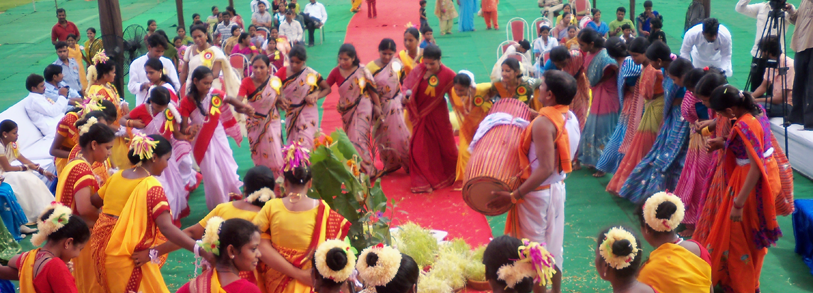History And Legends of Sarhul Festival
Sarhul is an important festival of the Oraon tribe of the Jharkhand region in India. Worshippers of nature, the Oarontribes celebrate the Sarhul festival when the Saal trees get new branches leaves and flowers. Another largest tribe of Jharkhand, Santals also celebrate the festival as the “festival of flowers”. It is called the “Baha”. The tribes use the Sal and Mahua flowers for the rituals.
The Sarhul festival is celebrated during spring season. The history of the Sarhul festival dates back to the period of Mahabharata as per several legends of Sarhul festival. The history of the Sarhul festival reveals that this festival is celebrated in the spring season. It is when the villagers offer prayers to the village God, the protector of the tribe. With the onset of spring and the blooming of flowers, the villagers start their celebration with lots of music and dance.
The Saal tree and its leaves play an important role in the festival.The Saal flowers are used for the worship of the deity. During the festival the Pahan (the village priest) fasts for a couple of days. A day before the main worship and rituals of the festival the Pahan brings three new pots made of clay and fills them with water.
After bathing early in the morning, the priest wears a dhoti made of pure cotton. Then he observes the water level inside the earthen pots. A decrease in water level is predicted to be the harbinger of famine or less rain, and if the level is same it symbolises ample rain.
Before the commencement of the religious ceremonies the Pahan’s wife washes his feet and seeks his blessings. During the rituals the villagers encircle the Sarna or the worship area. Then the priest offers three young roosters of different colours, one to the God the Almighty, known to the Munda, Ho and Orsan tribes as Singbonga or Dharmesh; another to the village Gods and Goddesses; and the third to the ancestors of the tribes.
While the Pahan chants the prayers the tribal drummers continuously play the traditional drum including Dhol, Nagara and Turhi.After the Pooja the Pahan is carried to his house by the boys where he is greeted by his wife who washes his feet. The Pahan offers the flowers of the Saal tree to his wife and the villagers and also puts the flowers on the roof of each house, which is called “PhoolKhonsi”. These flowers symbolize the brotherhood and friendship amongst villagers.
After all the rituals are over a beer made of rice, called Handia is offered as the “Prasad” of the prayers to the villager, who sing and dance and celebrate this festival with great zeal for weeks. It is believed that after this festival the earth becomes fertile and the process of sowing is started.
There are several legends of Sarhul festival popular amongst the masses of the Oraon tribes. One of manytraditional stories of Sarhulas narrated in the folk is; SaremBoodhi a demon was killed by simple tools and weapons like sticks etc by a brave son a widow from some tribal village. Therefore this festival is also known as “Khaddar GahiKhaddi” or the festival of the kids. As slowly this news spread to different villages, people began rejoicing and celebrating. Therefore, the festival is celebrated on different days of the spring season.
The history of Sarhul festival reveals several other folktales and Sarhul stories that throw light upon the life and beliefs of the Oraon tribe. Celebrated after “Phaagun” or March till “Jeth” or June, this festival has many reasons for its celebrations. Some of the Sarhul stories are related to nature and its grandeur. These Sarhul stories beautifully explain the importance of nature emphasizing on its preservation and growth. Some stories narrate the struggles of life and the joy after achieving the desired goal, which brings you to the mood of celebration. Some of the traditional Sarhul stories also portray the importance of family and the bond of love, care and respect that each family should possess. They also tell of advent of the new generation and the joy it brings. Moreover, it can be said that all the history and legends of Sarhul festival announce the celebration of new beginnings, new life, new birth, happiness and prosperity.








